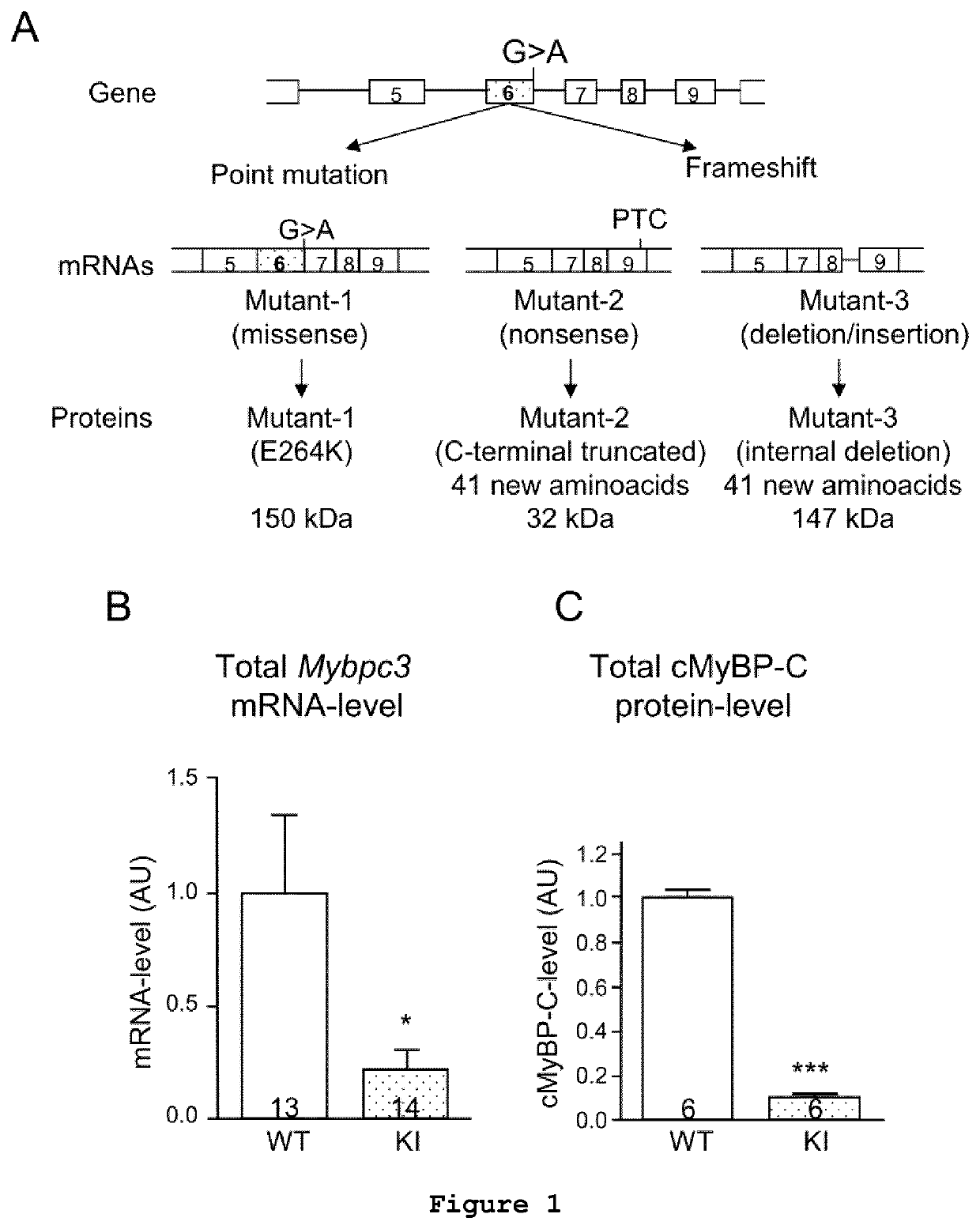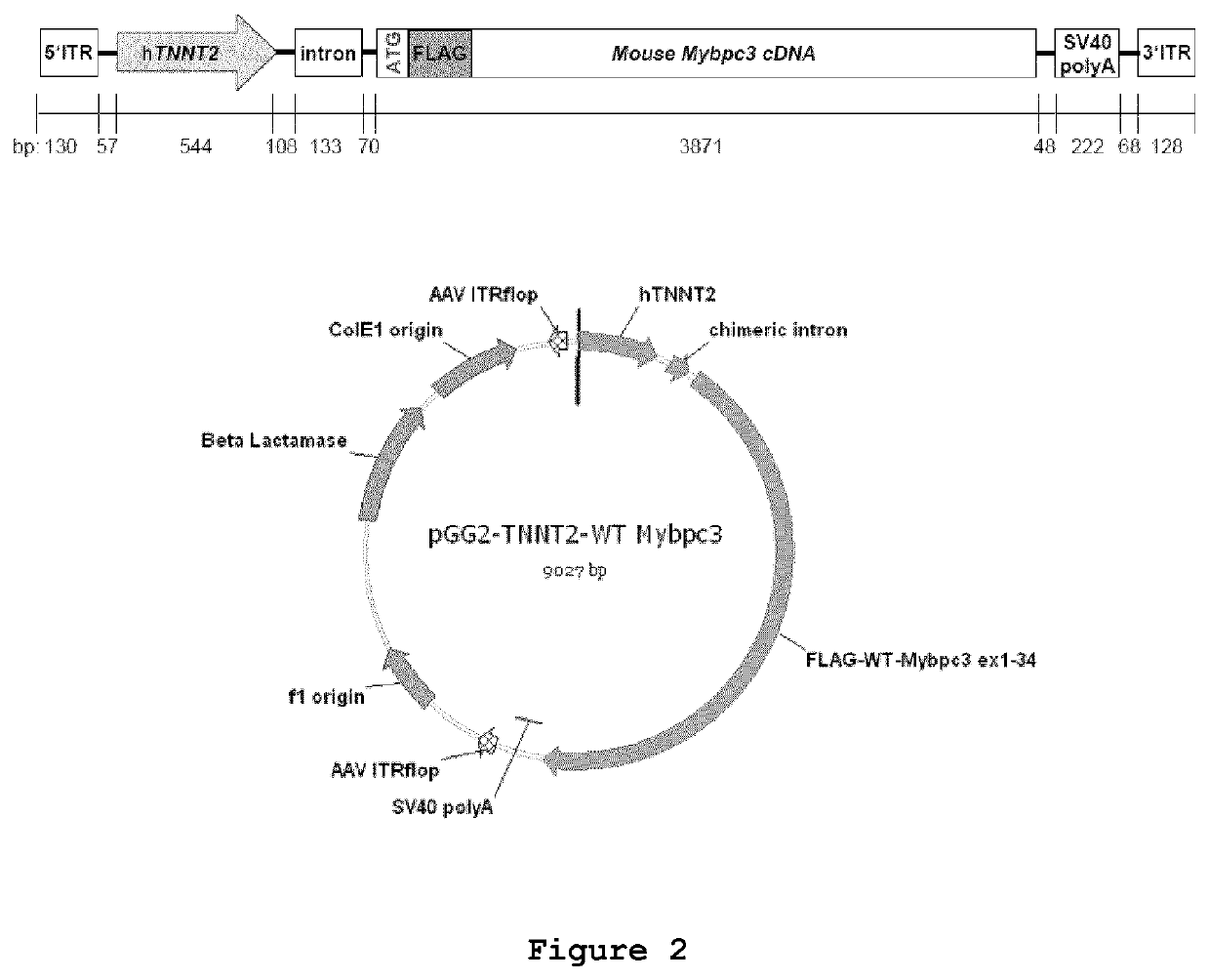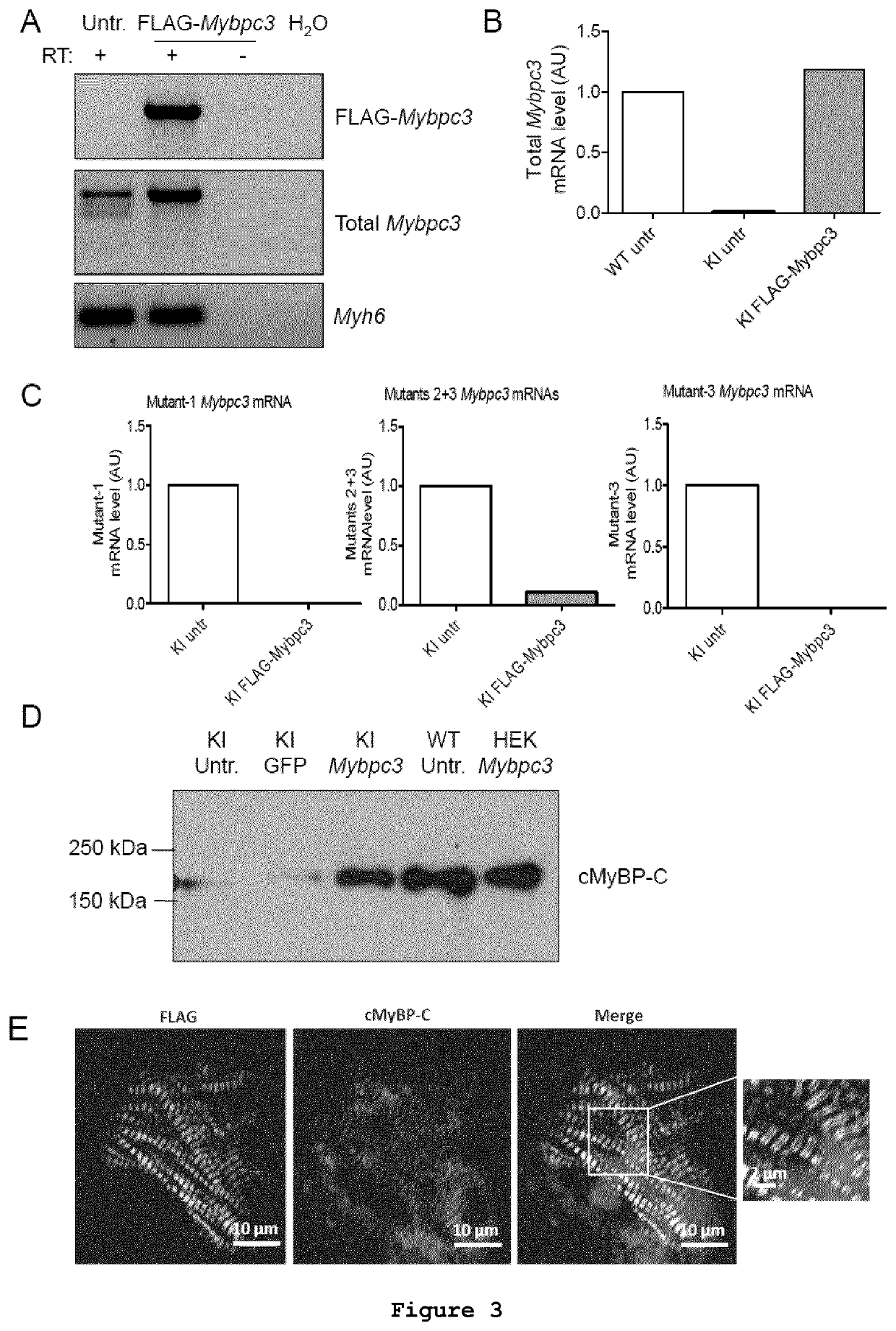Gene-therapy vectors for treating cardiomyopathy
a cardiomyopathy and gene therapy technology, applied in the direction of drug compositions, skeletal/connective tissue cells, peptide sources, etc., can solve the problems of genetic, dysfunction and hypertrophy, insufficient amount of full-length cmybp-c,
- Summary
- Abstract
- Description
- Claims
- Application Information
AI Technical Summary
Benefits of technology
Problems solved by technology
Method used
Image
Examples
example 1
Consequences of a G>A Transition in Homozygous Mybpc3-targeted Knock-in Mice
[0083]For both ex vivo and in vivo studies, a knock-in mouse carrying a G>A transition in the Mybpc3 gene (Mybpc3-targeted knock-in; KI) has been developed by gene targeting using the Cre / lox system (Vignier et al., 2009, Circ Res 105:239-248). Briefly, a 8105 bp-fragment containing the 5′ part of mouse Mybpc3 gene, which covers 1747 bp upstream of exon 1 up to exon 15, was obtained by long-range PCR or cloning from a FIX II genomic library derived from a 129 / Svj mouse strain, and then cloned into the pBluescript® II KS+ vector (Stratagene). The G>A transition on the last nucleotide of exon 6 was obtained by site-directed mutagenesis (Stratagene) on a 258 bp PCR fragment, which was then cloned into the Eco47RI / Nsi I sites.
[0084]The phenotype of KI mice appeared normal and they were viable for up to two years (Vignier et al., 2009, Circ Res, 105:239-248). Echocardiography was performed on wild-type (WT) and h...
example 2
Generation of a FLAG-Mybpc3-containing Vector
[0089]The vector pGG2-hTNNT2-WT-Mybpc3 was constructed by first amplifying the full-length FLAG-tagged mouse Mybpc3 cDNA (GenBank accession number NM_008653.2) including exons 1-34 by RT-PCR from mouse ventricular RNA using the forward primer #3 (5′-TTC GAC CTC GAG ATG GAT TAC AAG GAT GAC GAC GAT AAG CCT GGT GTG ACT GTT CTC AA-3′; SEQ ID NO:11) containing the XhoI restriction site and the FLAG sequence and reverse primer #4 (5′-TTC GAC GGA TCC CTG GTC ACT GAG GAA CTC G-3′; SEQ ID NO:12) containing BamHI restriction site. The human cardiac troponin T (hTNNT2) 5′ region from base −502 to +42 (GenBank accession number NG_007556.1; SEQ ID NO:5) was originally amplified from a human cDNA library by PCR using forward primer #5 (5′-AAA AAA ACG CGT CTC AGT CCA TTA GGA GCC AGT AGC-3′; SEQ ID NO:13) and reverse primer #6 (5′-CCC CCC CAA GCT TCT GCC GAC AGA TCC TGG AGG CG-3′; SEQ ID NO:14) enabling cloning with MluI / HindIII restriction enzymes in a ...
example 3
Evaluation of Mybpc3 mRNA and cMyBP-C Protein Levels and Localisation After Gene Transfer in Cardiac Myocytes Isolated from Mybpc3-targeted Neonatal KI Mice
[0092]Neonatal mouse cardiac myocytes were isolated from neonatal mouse hearts as previously described (Vignier et al., 2009, Circ Res 105:239-248). Cardiac myocytes were immediately transduced with AAV6-FLAG-Mybpc3 under the control of hTNNT2 at a multiplicity of infection (MOI) of 3000 for 30 min at 37° C. in suspension prior to plating (4.4×105 cells / well). Cardiac myocytes were kept in culture for 7 days at 37° C. and 10% CO2 prior to harvesting.
[0093]HEK293 cells were plated at a density of 2×105 cells in 12-well dishes in DMEM (10% FCS, 1% penicillin-streptomycin) and incubated at 37° C. with 7% CO2 until the recommended confluence of 50-70% was reached. The transient transfection of FLAG-Mybpc3 plasmid into adherent HEK293 cells was performed using the TurboFect transfection reagent (Fermentas) according to the manufacture...
PUM
| Property | Measurement | Unit |
|---|---|---|
| pH | aaaaa | aaaaa |
| pore size | aaaaa | aaaaa |
| diameter | aaaaa | aaaaa |
Abstract
Description
Claims
Application Information
 Login to View More
Login to View More - R&D
- Intellectual Property
- Life Sciences
- Materials
- Tech Scout
- Unparalleled Data Quality
- Higher Quality Content
- 60% Fewer Hallucinations
Browse by: Latest US Patents, China's latest patents, Technical Efficacy Thesaurus, Application Domain, Technology Topic, Popular Technical Reports.
© 2025 PatSnap. All rights reserved.Legal|Privacy policy|Modern Slavery Act Transparency Statement|Sitemap|About US| Contact US: help@patsnap.com



